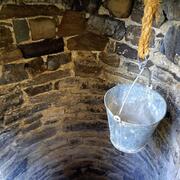Groundwater Flows Underground
Groundwater Data for the Nation
The USGS National Water Information System (NWIS) contains extensive groundwater data for thousands of sites nationwide.
Millions of cubic miles of water exists in the ground. You can't see it, but not only is it there, it is always moving around -- mostly downward, but also horizontally. Moving groundwater helps keep rivers full of water and allows for people to draw out water via wells. Moving groundwater is an important part of the water cycle.
• Water Science School HOME • Groundwater topics •
Groundwater Flows Underground

Credit: Howard Perlman, USGS
A neighbor's driveway with some water on it... not very exciting, but it is an excellent example of how groundwater flows underground and can seep back to the land surface. This simple process demonstrates one of the basic aspects of the water cycle.
This picture really demonstrates why there is water in many streams even after long periods of no rainfall. You have to "look below the surface" (pun intended) of what you see here. The water on the driveway is not runoff from the surface, but is seepage out of the ground after a downpour the day before.
During the rainstorm water soaked into the ground in the hill above the driveway. As happens with water below ground, it started moving along underground layers of soil and rock that are porous enough to allow water to move through it. After a storm, water doesn't move straight down into the ground, but, rather, it moves both downward and horizontally along permeable layers. The water is moving downhill ("down-gradient") toward a creek at the bottom of the hill.
Normally, the water would just flow underground to the bottom of the hill and seep out of the stream banks into the creek. But here the driveway was dug deep enough into the ground so that it cut into the permeable layer of soil that carries the underground water downhill. Thus, you can see groundwater seepage coming to the surface.
By the way, it is seepage such as this that helps keep water flowing in many creeks and streams during periods of drought.


Want to learn more about how groundwater flows underground? Follow me to the Groundwater Basics website!
Below are other science topics associated with groundwater.
Groundwater Information by Topic
Infiltration and the Water Cycle
Groundwater True/False Quiz
Groundwater Storage and the Water Cycle
How the U.S. Geological Survey Monitors Water
Below are publications associated with groundwater.
A primer on ground water A primer on ground water
Ground water and the rural homeowner Ground water and the rural homeowner
Millions of cubic miles of water exists in the ground. You can't see it, but not only is it there, it is always moving around -- mostly downward, but also horizontally. Moving groundwater helps keep rivers full of water and allows for people to draw out water via wells. Moving groundwater is an important part of the water cycle.
• Water Science School HOME • Groundwater topics •
Groundwater Flows Underground

Credit: Howard Perlman, USGS
A neighbor's driveway with some water on it... not very exciting, but it is an excellent example of how groundwater flows underground and can seep back to the land surface. This simple process demonstrates one of the basic aspects of the water cycle.
This picture really demonstrates why there is water in many streams even after long periods of no rainfall. You have to "look below the surface" (pun intended) of what you see here. The water on the driveway is not runoff from the surface, but is seepage out of the ground after a downpour the day before.
During the rainstorm water soaked into the ground in the hill above the driveway. As happens with water below ground, it started moving along underground layers of soil and rock that are porous enough to allow water to move through it. After a storm, water doesn't move straight down into the ground, but, rather, it moves both downward and horizontally along permeable layers. The water is moving downhill ("down-gradient") toward a creek at the bottom of the hill.
Normally, the water would just flow underground to the bottom of the hill and seep out of the stream banks into the creek. But here the driveway was dug deep enough into the ground so that it cut into the permeable layer of soil that carries the underground water downhill. Thus, you can see groundwater seepage coming to the surface.
By the way, it is seepage such as this that helps keep water flowing in many creeks and streams during periods of drought.


Want to learn more about how groundwater flows underground? Follow me to the Groundwater Basics website!
Below are other science topics associated with groundwater.
Groundwater Information by Topic
Infiltration and the Water Cycle
Groundwater True/False Quiz
Groundwater Storage and the Water Cycle
How the U.S. Geological Survey Monitors Water
Below are publications associated with groundwater.






